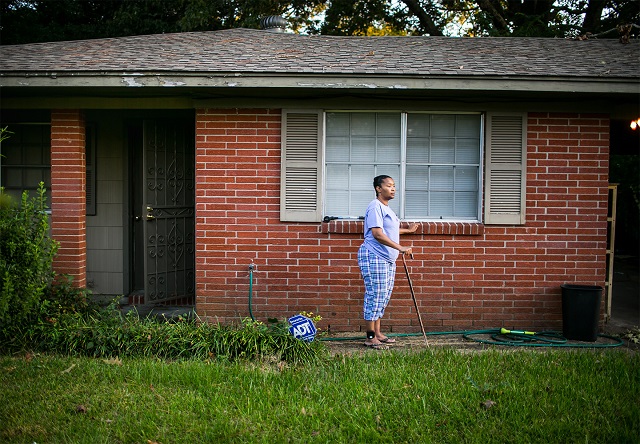
On a muggy Thursday morning in June, I drove through the gates of the Federal Correctional Institute in Tallahassee to meet a convicted criminal who, as far as I can tell, is the only person connected to two huge environmental contamination cases in Mississippi to ever serve prison time.
Yet, strangely, the convicted felon I was on my way to meet wasn’t a polluter. On the contrary, Tennie White, who was prosecuted by a joint team made up of attorneys from the Environmental Protection Agency and the environmental crimes division of the Justice Department, had spent her professional life exposing contamination. She was an environmental lab owner who was particularly vocal about protecting poor African-American communities. Before she was charged and prosecuted, White had spent much of her time volunteering for an organization she had co-founded to help these Mississippians contend with pollution.
Although White, who is 57, had spent years closely involved with dramatic cases that stood out even in a state with more than its share of the country’s industrial pollution — two of which in particular resulted in severe harm to many people and millions of dollars in cleanup costs — White’s prosecution wasn’t obviously related to any of these incidents. Indeed, the crime White had been convicted of didn’t seem to have any environmental consequences at all.
White was convicted in 2013 of “faking laboratory testing results and lying to federal investigators.” Maureen O’Mara, the special agent in charge of the EPA’s criminal enforcement program in Mississippi, explained in a press release that White’s conviction was essential to safeguarding the public’s health and that her “case demonstrates that individuals who falsify environmental records and try to mislead the government will be prosecuted and held accountable.”
During White’s trial, the federal prosecutor, Richard Powers, put it more simply: “This case is about lying.” White hadn’t been able to produce the original results for three wastewater tests an auto parts manufacturer named BorgWarner had hired her to perform, Powers explained to the jury at the start of her weeklong trial. He promised to convince them that she had never done the tests and had lied about them to EPA investigators. He successfully did so. On May 23, 2013, a jury found Tennie White guilty, and three months later, she was sentenced to 40 months in federal prison.
So when I heard White was being released to a halfway house after serving 27 months of her sentence, I decided to go down to meet her at the Federal Correctional Institute in Tallahassee to see for myself whether Tennie White was a fraud and a cheat, as the government attorneys contended, or perhaps, someone more complicated.
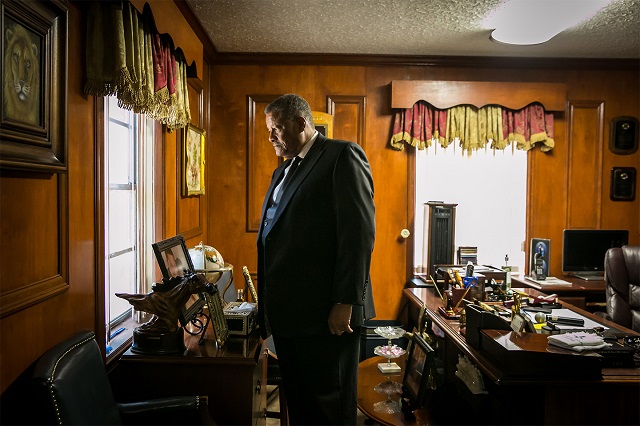 Reverend Steve Jamison in his office at Maranatha Faith Center in Columbus, Mississippi. The church sits on land polluted with creosote by the old Kerr-McGee site. (Photo: Nicole Craine for The Intercept)
Reverend Steve Jamison in his office at Maranatha Faith Center in Columbus, Mississippi. The church sits on land polluted with creosote by the old Kerr-McGee site. (Photo: Nicole Craine for The Intercept)
Rev. Steve Jamison is a big presence, tall with broad shoulders, a square jaw, and a thin, regal mustache that frowns over his mouth. Listening to his slow, precise baritone, it’s easy to understand how he wound up preaching.
In the mid-1980s, within a few years of founding the Maranatha Faith Center, Jamison was searching for a new building to accommodate his growing congregation. When he heard that a stone-faced A-frame church, complete with pews and stained-glass windows, was for sale on the north side of Columbus, Mississippi, he jumped at the chance.
Kerr-McGee Chemical Corporation was a giant energy and chemical company perhaps best known for operating the nuclear power plant where Karen Silkwood was poisoned by plutonium. But Jamison hadn’t seen the Meryl Streep movie about Silkwood when he bought the church. He knew the company simply as the owner of the factory just down the road. He didn’t even know what the plant made.
That changed in 1999, when Jamison decided to add a sanctuary onto his building to accommodate his growing congregation. His first step was to remove a culvert from the parking lot of the property so they could lay the foundation. Having worked many years in construction, Jamison didn’t hesitate to get down in the ditch with his crew. After only a few hours of digging, a strange, greasy jelly began to accumulate in the ditch. It looked like shiny beads, droplets that would ooze up from the soil. And as he and his crew dug deeper, more of it pooled in the dirt.
Jamison called the city, which sent a worker to investigate, who advised him that the goo was likely creosote, and that Jamison ought to call Kerr-McGee. Jamison did and soon one of the plant’s managers arrived at the site. “He said, ‘Well, that’s not our product,'” Jamison recently recalled. “And if it was, it wouldn’t hurt you.”
The plant had been using creosote, an oily mixture made with coal tar, as well as a toxic compound called pentachlorophenol, to preserve the wood of railroad ties since 1928, which also happens to be around the time that scientists were publishing the first studies linking creosote and cancer. Kerr-McGee acquired the plant from a company called Moss American in 1963. By the mid-1980s, Kerr-McGee was the country’s second largest supplier of railroad ties. By the time the manager was paying his visit to Jamison, it was clear that contact with creosote could cause kidney and liver problems, chemical burns, convulsions, and even death. That same year, in a groundwater monitoring report Kerr-McGee was required to file with the state and EPA as a result of earlier contamination, it measured several toxic components of creosote at dangerous levels on its property near Jamison’s church. One, napthalene, which is thought to cause anemia, cataracts, and cancer, was present at 25 times the drinking water level set by the EPA.
But Jamison knew little about railroad ties or chemicals, so he took the Kerr-McGee man at his word. He and his small crew returned to work, digging farther down and unearthing more and more of the weird, oily substance. Several weeks later, the plant manager called again, according to Jamison. “This time, he said, ‘We want to be a good neighbor. Would you mind if we came over and just removed that debris from the culverts so you can use them easily?'”
Jamison accepted the offer. But to his dismay the Kerr-McGee crew arrived wearing hazmat suits. He and his workers had just spent more than a month in direct contact with what he finally understood to be a dangerous substance — wearing no protection. Several members of the crew had already developed skin rashes and breathing problems. Jamison himself had begun to feel unwell while he was digging.
“Before I went into that ditch to work, I had perfect blood pressure, I had good kidneys,” said Jamison. “After six weeks of direct exposure, I came out, and my blood pressure was being controlled by four pills two times a day, and my kidneys were functioning at less than a third of their normal function.”
Jamison hired a local attorney, Wilbur Colom, and in 1999, the company offered him a $3 million settlement, according to Jamison. He refused the offer, and a subsequent one for $4.5 million, he said, because the money came with a catch: He wouldn’t be able to tell anyone what had happened. Keeping the toxic goo secret and leaving others in harm’s way “didn’t seem like the pastoral thing to do.”
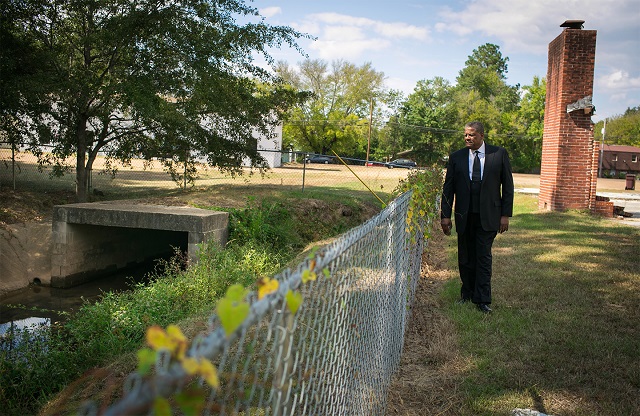 Rev. Steve Jamison walks alongside a polluted ditch that flows through the property of Maranatha Faith Center in Columbus, Mississippi. The ditch is where Jamison first discovered creosote flushed out from the old Kerr-McGee site. (Photo: Nicole Craine for The Intercept)
Rev. Steve Jamison walks alongside a polluted ditch that flows through the property of Maranatha Faith Center in Columbus, Mississippi. The ditch is where Jamison first discovered creosote flushed out from the old Kerr-McGee site. (Photo: Nicole Craine for The Intercept)
But plenty of people involved in the Columbus mess didn’t seem to be holding themselves to such high standards. According to Jamison, one of the deacons of the First Assembly of God of Columbus, the mostly white church that had sold him the property, later told him that several people in the congregation had known about the contamination and that it made the property essentially worthless.
The deacon has since died, and the current pastor of the First Assembly of God, Jody Gurley, disputed Jamison’s account. “There was never any environmental testing done or required,” said Gurley, who has only led the church for the past five years but has spoken about the sale with members of his congregation who remember it. “It wasn’t like they were trying to dump the property off,” he said. But Gurley added that Jamison might have expected the contamination. “Because of the location, I’m not surprised. You could see runoff from Kerr-McGee. You could always see the runoff.”
Jamison also learned that Kerr-McGee had known for years about the dangers of its plant. In 1997, one of Kerr-McGee’s environmental project managers, Steven Ladner, contacted the EPA’s office of solid waste to report creosote contamination at seven of its plants, including the one in Columbus. Ladner told agency staffer C. Pan Lee that the sites had “quite extensive contaminated areas” that would make cleanup difficult, according to a transcript of the call.
Yet Kerr-McGee managers publicly downplayed or lied about the extensive contamination at the plant, according to more than a dozen former workers interviewed on tape by a local documentary filmmaker. Creosote spills occurred daily, they said. And many big spills that should have been reported to authorities were kept secret and covered up with soap powder, dirt, gravel, or sawdust. Plant workers also did extensive cleanups before visits and inspections.
Mark Finch, who worked at the Kerr-McGee plant for 10 years, was repeatedly warned that reporting leaks and spills to the EPA was “not a good career move.” After accurately filling out reports and sending them to the federal agency, Finch was fired in 2002.
After Jamison filed his lawsuit over the contamination at Maranatha, Kerr-McGee attorneys instructed some of the plant workers not to speak to lawyers or the press. “They told us it was best for us to keep our mouths shut or we’d be in trouble,” said Jerrie Lewis Brooks, who worked at the Columbus plant for 15 years.
Jamison even contacted Johnnie Cochran, the attorney famous for taking high-profile cases, including O.J. Simpson’s. At first it seemed that Cochran was going to take the case, and he went down to Mississippi in 2001 to talk about how the plight of the Maranatha congregation fit into the larger pattern of environmental injustice in America. “Black communities make easy victims for careless corporations,” he told the crowd that assembled to hear him. “If you continue looking the other way when the powerless are wronged, then nothing will ever change.”
Cochran told Jamison that his was “the perfect case of Goliath and David.” But about two months after Cochran agreed to represent the church, the pastor saw him on TV signing a contract with the NFL Players Association. “One of Kerr-McGee’s lawyers that I knew was there as the NFL lawyer,” said Jamison. And when he suggested to Cochran that getting a job through the lawyers representing his opponents might pose a conflict, Jamison said, Cochran dropped his case.
Just after he discovered the creosote, it seemed Jamison would get the help of the state environmental agency, the Mississippi Department of Environmental Quality, to whom he reported the discovery. In late 1999, the MDEQ issued an order requiring Kerr-McGee to clean his property. But for the next eight years, the ditch remained just as it was — half-dug in the lot outside the church. In 2004, the plant shut down, and still no one came to clean up his property, leaving Jamison unable to complete his extension. It wasn’t until 2007 that the city of Columbus used money from a grant from the U.S. Department of Agriculture to pave it over.
From that point on, Kerr-McGee’s lawyers contended that Jamison’s property had been remediated. Jamison’s attorney hired a consultant named Lois George to test the soil and she reported to him, and to the court, that there was no creosote on the land.
Kerr-McGee no longer exists as a company, but at the time a spokesperson named Debbie Schramm said, “Our environmental performance has been nationally recognized for environmental responsibility, and our plants operate safely and have not harmed anyone.”
Jamison, though, remained convinced there was still creosote on the church property. He had seen how much of it had oozed from the ditch. And he had watched the workers from the city do their work. He knew that none of them had removed or processed the soil before paving it over, but he was unable to prove his suspicions. The city claimed he couldn’t remove the concrete to dig in his own churchyard because the culvert was now government property.
It was only when Jamison hired Tennie White, someone his friend recommended as both knowledgeable about contamination and beyond the reach of his powerful neighbor, that he was able to get to the truth of what lay in the soil under his church.
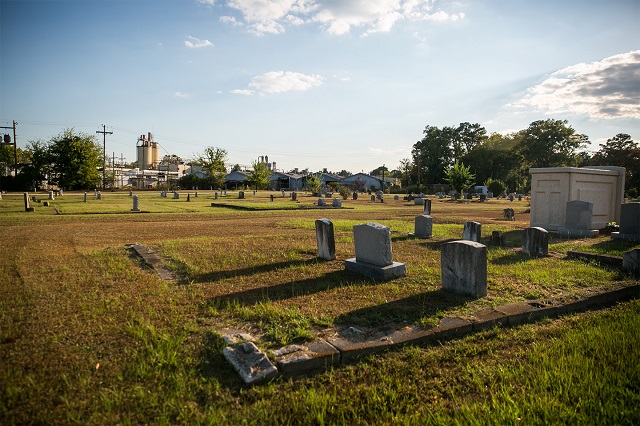 Union Cemetery, a graveyard in Columbus, Mississippi, located between the old Kerr-McGee plant and the now-closed Sanderson Plumbing Products factory. (Photo: Nicole Craine for The Intercept)
Union Cemetery, a graveyard in Columbus, Mississippi, located between the old Kerr-McGee plant and the now-closed Sanderson Plumbing Products factory. (Photo: Nicole Craine for The Intercept)
While Kerr-McGee was fighting Rev. Jamison in court, the company was also working on a much bigger plan to avoid the consequences of its pollution. The pastor of the small church in Columbus, it turned out, was only a tiny part of the company’s environmental troubles: The company had already settled some 15,000 suits over creosote contamination and Jamison’s was just one of 9,450 more that were pending. Kerr-McGee also had many other businesses, including uranium mines, oil refineries, gas plants, offshore drilling operations, and plutonium pellet factories, and virtually all of them had left environmental messes behind.
After more than 70 years of operation, Kerr-McGee’s toxic legacy took the form of agricultural chemicals, rocket fuel, decaying nuclear isotopes, and all manner of harmful substances spread over more than 2,700 contaminated sites in 47 states including Florida, New Jersey, Idaho, Illinois, Wisconsin, and North Carolina. The cost of cleaning these sites — and compensating all the people who had been harmed by them — was so great it threatened the giant energy company’s very future.
The extent of the unpleasant financial consequences of the toxic messes was made clear to the company in 1999, when the EPA told Kerr-McGee it would have to pay more than $178 million to clean up a creosote factory in Manville, New Jersey. Soon after, the company began seeking advice on how to free itself from its unwanted environmental baggage. In 2000 one of its investment bankers, Lehman Brothers, came up with a plan.
The idea of “Project Focus” was to separate the profitable part of Kerr-McGee from the liabilities that were weighing it down. By early 2000, the company’s board of directors had begun to put the plan into action by creating a new company into which they transferred their profitable assets, including oil and gas holdings worth billions of dollars.
What was left after the transfers was Kerr-McGee’s moderately profitable business making a white pigment called titanium dioxide — that and responsibility for what turned out to be billions of dollars worth of environmental liabilities, $442 million in pension costs, and $186 million in “other post-employment benefits.”
Kerr-McGee put this company — with only $40 million in cash and its titanium dioxide business to offset all those debts — up for sale in 2005. The liabilities were so great they threatened to drag the whole business under, as was made clear in a sketch Lehman Brothers Managing Director Chris Watson drew on a whiteboard to illustrate the structure of the deal. In the drawing, according to court documents, the titanium dioxide business was depicted as a flower sharing a pot with weeds that the banker labeled as “Kerr-McGee’s environmental legacies.”
Kerr-McGee tried to put a positive spin on the debt-laden enterprise when it announced its separation in 2005 with an upbeat press release: “Current market conditions for this industry now make it an ideal time to unlock this value for our stockholders.” The market saw through the scheme, however, and no buyers stepped forward. So later that year, Kerr-McGee spun off its liabilities and debts into a new company called Tronox Inc.
It was 2009 when Tennie White first stumbled across the name Tronox. She had gone to the EPA’s reading room in Washington, D.C., on behalf of Jamison to read the files relevant to the Columbus site. The name surprised her. Up to a certain point in time, all the documents listed Kerr-McGee as the party responsible for the contamination. Suddenly, in the most recent files, Tronox had appeared.
By the time White was puzzling over the significance of Tronox, the weeds had already won out. In 2009, overcome with debt less than three years after it was created, Tronox filed for bankruptcy, leaving Jamison and more than 7,000 others who lived on or near the contaminated sites with little hope of getting justice. They couldn’t get compensation from Tronox because it was bankrupt. Nor could they turn to what was left of Kerr-McGee. In 2006, just six months after the spinoff relieved the company of its unappealing debt burden, Anadarko, another giant energy company, had snapped up the profitable part of Kerr-McGee for $18 billion.
Kerr-McGee, the Goliath Jamison had been battling for a decade, had disappeared.
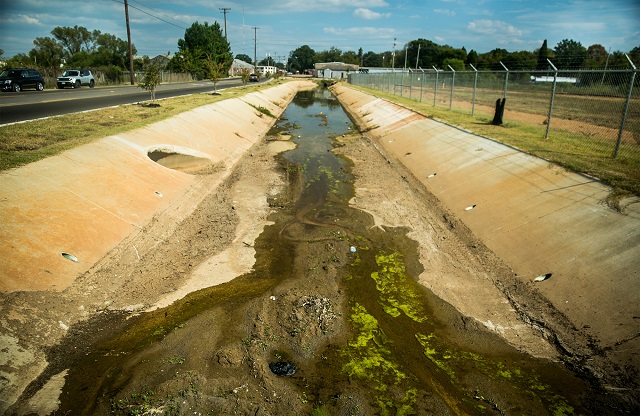 A polluted ditch containing creosote runs along the property of the old Kerr-McGee site in Columbus, Mississippi. (Photo: Nicole Craine for The Intercept)
A polluted ditch containing creosote runs along the property of the old Kerr-McGee site in Columbus, Mississippi. (Photo: Nicole Craine for The Intercept)
Tennie White got her first environmental job in 1981 through an ad in the paper. Newly married with a young son, she would have been happy with almost any job. But she truly loved the one she found as a lab analyst for a Jackson-based company called Environmental Protection Systems. Though she knew nothing about the work when she started, the company taught her how to collect and prepare soil and water samples and run various tests on them. The work fascinated her. Each test had its own precise protocol and she never knew until she ran it what the results would be.
In 1995, after about 10 years with Environmental Protection Systems and several years working for a metal finishing company, White went out on her own, founding an environmental laboratory that did asbestos removal as well as tests for an ever-shifting cast of contaminants at different industrial sites. Over the years, even as the particulars of the work changed, White began to notice that certain things remained the same. A lot of the sites she was hired to test were in small towns that had been polluted by big companies. And the people who lived there were often poor and didn’t understand the dangers the contamination posed.
By the time Jamison reached out to White to see if she would help him prove there was creosote contamination on his property, White had worked as a lab analyst on many similar cases, in which various industries had left chemicals in the soil and water.
For years, White had a straightforward role in these cases — to run tests. She had enjoyed letting the test results speak for themselves. But now she found herself in a different position. She had recently been to Hattiesburg, in southern Mississippi, where Kerr-McGee had also insisted there was no creosote contamination. While she was attending a community meeting there, she began to fully appreciate, for the first time, how the numbers she had been calculating for years affected actual men, women, and children.
“The people became real,” was how she remembered it recently. Some of the Hattiesburg residents told her about the smells that used to waft down their streets from the plant and the rashes their children had suffered for years. In the late 1980s, she had done some testing on the site of a local Ford dealership and found creosote, and on that more recent visit, she saw children playing in what she was pretty certain was contaminated mud.
From reading through the state’s files, White knew that Mississippi had handled other cases of creosote contamination differently. For instance, in Wiggins, Mississippi, a town that was about two-thirds white, both the EPA and the state environmental agency had designated a similar situation an emergency and remediated the contamination in less than a year. The neighborhoods affected by creosote contamination in Hattiesburg and Columbus, by contrast, were mostly black, and the problems there had gone unaddressed for many years.
When she was growing up, White’s parents used to tell her about their own childhoods in rural Mississippi towns during the Jim Crow era. She used to think that the indignities they suffered — having to get off the sidewalk when white people were coming and knowing you weren’t supposed to look them in the eye — were relics of the past. But the disrespect she saw in the contamination of these poor black communities felt directly connected to the struggles of her parents’ generation.
Cleaning up only contamination that affected white people — and knowingly leaving that found in poor black neighborhoods — was just another form of racism. And, as she told the city council of Hattiesburg in June 2008, it was criminal.
White took a close look at the report prepared by Lois George, the environmental consultant Jamison’s lawyer had hired and realized that the detection levels for the contaminants had been set higher than the action levels the EPA had set for those chemicals. White says she repeatedly asked George to provide the original test results on which her report was based, but never received the data. Lois George declined a request to comment for this article, citing client confidentiality.
From her years analyzing samples, White knew that “if you want to cover up some environmental contamination, you just raise the detection limits and then there appears to be nothing there.” So White and Jamison came up with a plan they hoped would force the government to test the soil again. Although city officials had warned Jamison not to move the concrete, on June 4, 2009, they rented a backhoe and did just that. Then White placed a call to 911 to report an open hole — a situation she knew obligated authorities to respond immediately, under state law. The MDEQ sent someone to the site but didn’t test the substance they had unearthed.
White then called the EPA, which a week later sent investigators who hauled off boxes of soil — many of which proved to be contaminated. In July, White wrote to Lisa Jackson, then head of the EPA, “on behalf of 24,700 citizens of Columbus,” to get the EPA’s help with the cleanup. In October, White wrote to the EPA again, noting that 8,976 people living within one mile of the Kerr plant, including 1,030 children, were being exposed to “unacceptable levels of Creosote and Creosote Break Down products.”
The EPA issued its final analytical report on the Columbus site in March 2011, which noted that levels of six carcinogenic semi-volatile organic compounds exceeded the recommended action levels, sometimes by more than six times. The contaminated spots included the playing field of the local middle school. By September 2011, the agency had designated a 90-acre tract that included the plant a superfund site. The cleanup, which began more than two years ago, is expected to cost some $67 million and last at least another three years. Since remediation of the area nearest Jamison’s church began in mid-October, J5, the construction management at the firm in charge of the project, removed some 600 tons of creosote-contaminated soil, according to Robyn Eastman, a director at J5. Eastman says he expects to remove another 600 tons before the section is finished in December.
Along the way to what was arguably her biggest achievement, White managed to anger pretty much every authority figure she encountered. The woman who had once taken comfort in sticking to the numbers began firing off outraged letters.
When the MDEQ failed to respond to her requests to test for creosote in Columbus, she went above their heads, contacting the federal authorities directly. In October 2009, she made an official complaint charging that the MDEQ and the EPA were guilty of environmental injustice. After investigating her complaint, the EPA’s office of the inspector general responded that the agency hadn’t found any evidence it had done anything wrong. In a letter, White replied “that OIG couldn’t find mud after a raging flood.”
She also wrote to the attorney general of Mississippi and suggested that the Mississippi Department of Environmental Quality had failed to test the samples in Columbus because the affected locals were mostly poor and black. She sent copies of the letter to the FBI, the EPA, and the Justice Department.
Two months later, she wrote to Lisa Jackson, then the head of the EPA, suggesting that “the residents of Columbus appear to be participating in a Tuskegee Controlled Experiment to determine the health effects of Dioxins, Phthalate Esters and PAHs on African-Americans.” She posted pieces online accusing both the EPA and the MDEQ of environmental racism.
And while the gap between black and white infant mortality is often described as a complex mystery caused by a mix of factors, including income, nutrition, and education, White seemed to feel it all could be explained by environmental racism. While a more measured person might have described the different treatment of black communities as contributing to the problem, White laid responsibility for Mississippi’s startlingly high African-American infant mortality rate directly at polluters’ feet.
“Her mantra was, ‘You’re killing my babies,'” said Jamison.
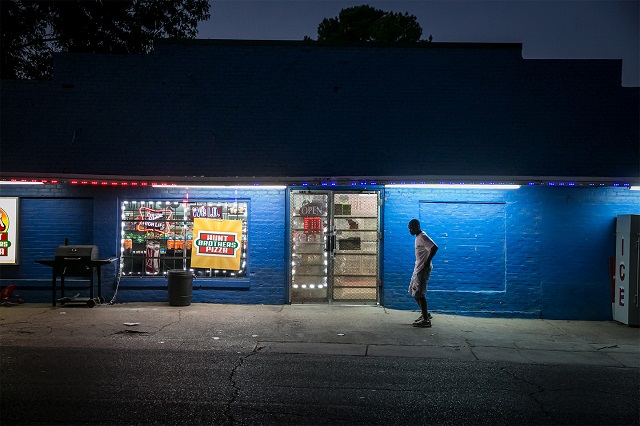 A local convenience store and pizza joint sits along 14th Avenue, across from the old Kerr McGee plant in Columbus, Mississippi. (Photo: Nicole Craine for The Intercept)
A local convenience store and pizza joint sits along 14th Avenue, across from the old Kerr McGee plant in Columbus, Mississippi. (Photo: Nicole Craine for The Intercept)
In the latter part of 2009, after she had worked on the Columbus site for about a year, White teamed up with Jamison and a labor organizer named Sherri Jones to find a way to connect the people in small towns in Mississippi, Alabama, Florida, and Tennessee who were struggling with similar environmental problems. Together, they felt, these communities had a better shot at calling attention to their problems than on their own.
With the creation of the Coalition of Communities for Environmental Justice, White completed her transition from lab analyst to activist. She traveled throughout the state, often with Jones and Jamison, talking about environmental issues in black communities. She went to Columbia, where the former Reichhold Chemical plant had illegally buried thousands of drums of chemical waste. She went to Palmers Crossing, the African-American community in Hattiesburg where creosote was found. And she went to Grenada and Pickens, other Mississippi towns that, like Columbus and Hattiesburg, had been contaminated with creosote from Kerr-McGee plants.
White also went back to Crystal Springs, a small town about half an hour south of Jackson, where her testing had turned up contamination almost a decade earlier.
In 2000, BorgWarner, an auto parts manufacturer, hired an environmental consultant who contracted White to test the soil around property that BorgWarner had recently bought from another company. After two days of testing, she found several toxic chemicals, including carcinogenic PCBs, at well above the legal limit. One chemical, Aroclor 1268, was present in soil samples at more than 2,000 times the safety level set by the EPA. The contaminated areas included backyards where children played as well as the local high school’s football field, where students and their families were being unwittingly exposed to carcinogens.
White reported her findings to the plant manager, who said he didn’t want to report the contamination to the state. Such a response was fairly typical, she said, as was her own: According to state law, the company had 24 hours to notify the Mississippi Department of Environmental Quality of the results. “And if they didn’t, I would have to.”
In the intervening years, after the people of the town had sued over their exposure to the carcinogenic chemicals, that discovery had wound up costing BorgWarner, which owned a plant there, some $50 million in remediation costs, and lawsuits over contamination ran the company at least an additional $39 million.
BorgWarner declined to comment for this article.
In 2009, White and Jones attended a meeting of the Crystal Springs City Council and offered advice to the members about how to find clean water. White told them that BorgWarner, as the polluter, was responsible for coming up with a source of clean water — not the residents of Crystal Springs.
To Jones, White was a perfect addition to the coalition. She understood environmental law and the technical terms and reports that were beyond the grasp of most of the affected people. She was committed, working long hours without pay. Perhaps most importantly, over her more than 20 years as a lab analyst, she had done testing in several of the communities that were part of the coalition. “She knew where all the bones was buried,” said Jones.
Their plan — to support the communities and highlight environmental racism in the Deep South — seemed to be working. “They were beginning to get attention,” said Heather Sanchez, a graduate student who wrote her master’s thesis about the coalition’s work in Hattiesburg. People began to call them when they encountered environmental problems. And residents of the various towns began sharing contacts and information.
But people close to White became concerned that her outspokenness might get her into trouble. Jones, who lived in Jackson at the time, traveled with her whenever he could. When he couldn’t, he made sure to talk with her on phone while she drove.
“This is Mississippi,” said Jones. “We worried about her life.”
Jamison was worried, too. “We tried to get Tennie to calm down,” he said. “She’s very passionate. I said, ‘Tennie, you’re fighting some big, big boys here. Let’s take it one at a time.'”
So in 2012, when White was charged with fraud by the EPA, the organization she so often criticized, and the charges involved a company she had helped a community challenge, Jamison, Jones, and others who had been working closely with her felt they knew exactly what had happened.
“She was framed,” said Jamison. “It was that simple.”
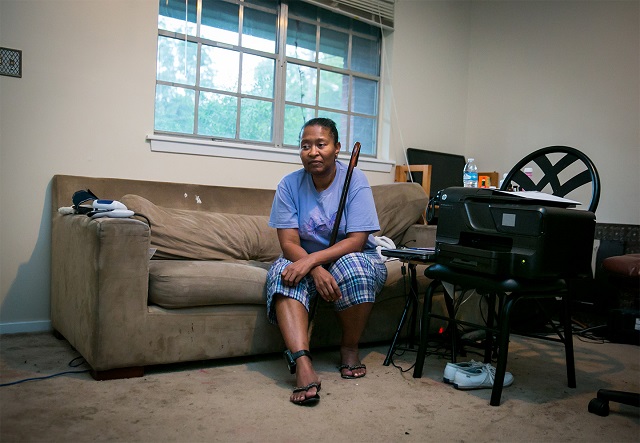 Tennie White at her home in Jackson, Mississippi. White, currently on house arrest, uses her living room as a home office to continue fighting against environmental pollution. (Photo: Nicole Craine for The Intercept)
Tennie White at her home in Jackson, Mississippi. White, currently on house arrest, uses her living room as a home office to continue fighting against environmental pollution. (Photo: Nicole Craine for The Intercept)
When the government agent first appeared at the door of her lab on July 24, 2009, Tennie White assumed he was from the FBI and had come to talk about her work in Columbus. White had recently filed a complaint arguing that Kerr-McGee was placing people in harm’s way and had notified the FBI because she hadn’t gotten any response from either the EPA or MDEQ.
But the man who came to her office in Jackson was actually from the EPA. Matthew Anderson was a special agent in the EPA’s criminal investigations division, part of an elite team of armed “green cops” who run down environmental criminals. They interview suspects, sort through evidence, and put together cases that they then hand off to prosecutors.
Anderson wanted to talk about tests that BorgWarner had hired White to do in Water Valley, a small town south of Oxford. The company, which makes parts for car transmissions, releases the water it uses to wash the parts into the nearby Otoucalofa Creek. To ensure that the levels of certain metals are within required limits, it has to test its wastewater each month. In October 2008, BorgWarner asked White to submit a discharge monitoring report that summarized the test results to the company. And she had. But Anderson said he wanted the original test results. White told him that Robert Wilson, the BorgWarner employee who had hired her to do the tests, had the originals. She also said that she would send the results to Anderson.
Six months later, in January 2010, Anderson returned with another EPA special agent, Ricky D. Knight, and this time, after asking White about the test results, the two men left with her computer hard drive. On it, they testified during the trial, were files in which White had copied a signature that had been on a report another environmental lab had produced about the Columbus site — and affixed the copied signature to the BorgWarner report.
The trial, which was held in the U.S. district courthouse in Jackson, hinged on the question of what happened to the original test results — and whether White had actually performed the three tests, each of which cost the company $150. The copied signature, they argued, was evidence that White had been in the process of falsifying the original test results.
White’s two court-appointed attorneys argued that there was no evidence BorgWarner’s output to the creek ever caused any harm — a contention that the government prosecutors never disputed. They pointed out that because the wastewater went into a creek that wasn’t a federal waterway, the whole matter was outside the EPA’s jurisdiction and that there was no contract between BorgWarner and Tennie. The defense attorneys also argued that, because Tennie was supposed to give the test results to a private company and not the EPA, their dispute wasn’t a federal matter. (The EPA itself had used this argument when responding to White’s complaint about their failure to look into the testing done in Columbus by Lois George; because George’s data hadn’t been submitted to the EPA, the agency claimed, it was outside its jurisdiction.)
Oddly, though the EPA was helping prosecute her case and many of the witnesses testifying against her were from the Mississippi Department of Environmental Quality, White’s attorneys never mentioned her long history confronting these organizations. And though BorgWarner’s employees made up most of the witnesses for the prosecution, her attorneys never told the jury that she had been involved in a case that had cost the company so dearly. Her attorneys declined to be interviewed for this article.
Perhaps the strangest part was that White’s lawyers never called to the stand the person who seemed to hold the answer to whether she had performed the tests: Robert Wilson, the BorgWarner employee who hired White and was in the best position to evaluate whether she had performed the tests. Though prosecutors referred to him by name more than 100 times during the trial, they never asked Wilson to testify either.
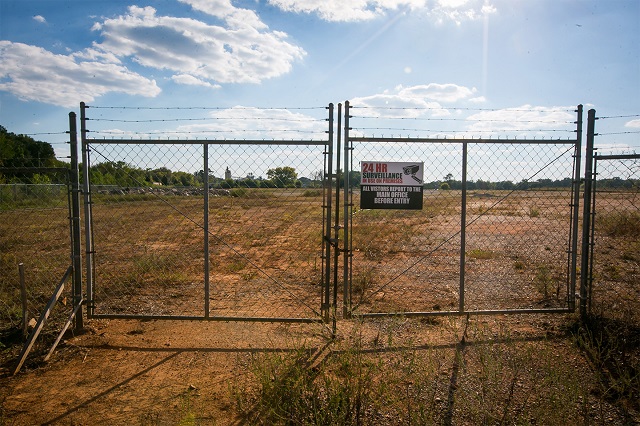 The old Kerr-McGee property in Columbus, Mississippi, has since been designated a superfund site. (Photo: Nicole Craine for The Intercept)
The old Kerr-McGee property in Columbus, Mississippi, has since been designated a superfund site. (Photo: Nicole Craine for The Intercept)
I reached Robert Wilson by telephone at his home in LaGrange, Georgia, and later followed up via email. When I asked why he didn’t testify during White’s trial, he had a strange answer: The prosecuting attorneys had him “holed up in the basement” of the courthouse. They had told him he would be there until he testified but then never called him to the witness stand.
Wilson, it turned out, had known White since the mid-1990s and had worked with her since 2003 doing lead removal, asbestos inspections and abatement, and other environmental work. When Wilson took a position as an environmental health and safety manager for BorgWarner in 2008, he noticed that the lab the company was using to test its wastewater had a turnaround time of more than three days. So he asked White, who he felt confident could produce the results within one day, if she would run the tests and she agreed.
Wilson went on to extol White’s professional virtues, noting the diligence she brought to the work. “I’ve seen her stay up till 1 and 2 in the morning because they’d bring up 100 samples that are timed. She’d sit at that microscope for hours at a time,” said Wilson. “She was meticulous for each sample. Normally people’d get jaded. They’d check 57 in a row and figure the last four would be good. Not her. She’d check every last one.”
Wilson and White were friendly during the time they worked together, playing chess at lunchtime and having good-natured competitions over their knowledge of environmental law. Wilson still has one of the statutes they had argued about pinned to his bulletin board, describing it as “the one time out of 100 that we discussed that she was wrong.”
When I asked whether he thought White was guilty of the fraud charges related to those tests, Wilson didn’t hesitate. “I don’t believe it, I’m sorry,” he said, adding, “You can stack those agents yay high and I still won’t believe you.” After reading the transcript of the trial, which I sent him, Wilson later admitted that it was possible and that the testimony had “put a doubt” in his mind. But, he added, “Whether it’s probable is a whole other matter.”
As Wilson sees it, his colleague and friend had no reason to lie. “What is her motivation for risking her whole career and reputation for a $150 test? That makes no sense to me whatsoever.” On the other hand, Wilson believed companies might want to punish her or banish her from the environmental field. “She stepped on the wrong toes,” is how explained her prosecution, which he described as “a charade.” “I even tried to warn her at that time that you need to watch yourself because these people don’t play. You have the possibility of causing them multimillion dollars in lawsuits and expenses and, Tennie, they’ll come after you with a sledgehammer.”
The EPA special agents who came to ask him about White in 2009 or 2010 did seem eager to dig up anything negative about White. Wilson was working at Siemens Energy in Ridgeland, Mississippi, at the time and Anderson, Knight, and a third man came to his office, according to Wilson. The agents told him that White had implicated him in the fraud case and he responded that he didn’t believe them. The agents, Wilson said, then “changed tactics and just questioned me about the time I had worked with her.”
Wilson said that sometime in 2013, Special Agent Anderson flew from Florida to see him again and described their visit this way: “He asked a lot of questions that were more of a personal nature than professional and seemed to want personal information on Ms. White. When it got to the point that he asked if we ever had a sexual relationship, I invited him to leave my office and not to contact me again.”
“At that point they were grasping at straws. They were trying to decimate her personal life or character assassination,” said Wilson. “It became a quest to decimate this lady not only professionally but personally as well.” The agents also dug up White’s financial information, including the fact that she had defaulted on a bank loan she took out to pay for her lab, which the prosecution later presented in court.
I submitted a Freedom of Information Act request to the EPA for all communications relating to the investigation of Tennie White in April 2016. The agency is supposed to resolve such requests within 20 business days, but I did not receive all the documents I requested. After months of being sent from one division of the EPA to another, I reached Tom Seaton, a deputy director in the legal counsel division of the office of criminal enforcement, who admitted that my request had been “totally mishandled” and that I had “a right to be unhappy.” Seaton said he would try to send me the special agents’ emails that referred to the White case, but he never did.
Wilson reported to the small room at the bottom of the courthouse for most of the trial. But as it drew to a close, he was released and watched the closing statements from the courtroom. He described seeing rows of prosecutors. On one side, were “the DOJ lawyers from Washington. And then you had the EPA guys lined up next to them. They were an impressive sight. Then on the other side you have one court-appointed lawyer next to this poor little black woman,” Wilson said, adding. “She’d kill me if she heard me say that. To me, it looked like they just took a sledgehammer to a flea.”
“I’m amazed at the lawyers they sent from the Justice Department out of Washington, D.C., and all the trouble they went to to prosecute a small-time little black businesswoman in Jackson, Mississippi,” said Wilson. “You don’t bring that much firepower if you’re going to be stepping on ants. Somebody wanted Tennie put away.”
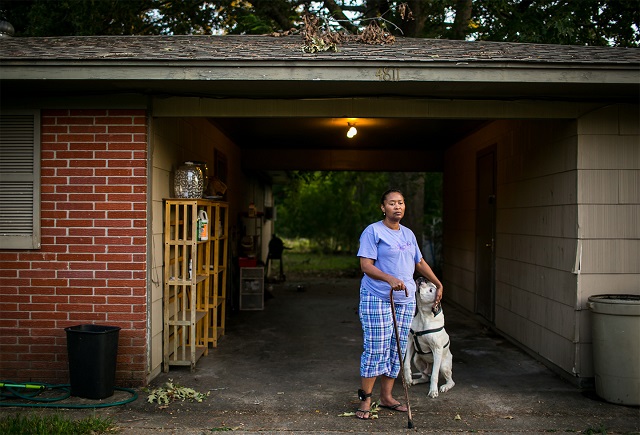 Tennie White outside of her home in Jackson, Mississippi. White is awaiting surgery for her cataracts; her eyesight has worsened to the point where she needs help getting around. (Photo: Nicole Craine for The Intercept)
Tennie White outside of her home in Jackson, Mississippi. White is awaiting surgery for her cataracts; her eyesight has worsened to the point where she needs help getting around. (Photo: Nicole Craine for The Intercept)
White insisted that she performed the three $150 tests at the center of her fraud conviction. Whether she did it or not, it seems she was guilty of at least one thing the prosecuting attorneys brought up during her sentencing. She lied about having graduated from college. Though she did attend Millsaps College in Jackson, Mississippi, for at least three years, White never finished, according to the testimony of a Millsaps registrar.
Yet White said she had a degree when she applied for a loan to start her business in 1995. When she applied to be a HUD inspector in 2005, according to prosecutors, she went as far as to doctor one of her own undergraduate transcripts so it looked as though she had taken graduate courses. (White denies changing her transcripts.) White also lied about having a college degree twice under oath when testifying as an expert witness in unrelated trials. To me, she admitted that “she had never marched” at graduation.
Though lying about such things can be prosecuted as perjury, it rarely is. (There has been little consequence for Melania Trump, for instance, who seems to have both falsely claimed to have a college degree and lied about it under oath.) And White wasn’t being tried for perjury. But at her sentencing hearing, the prosecutors presented the forgery and lies about her degree as evidence of further criminal conduct, which, they argued, meant that she deserved to spend more time in prison than the 15-21 months laid out in the guidelines for “abuse of trust.” The judge clearly agreed, giving White 40 months in prison as well as an additional three years of supervised release and a $1,000 fine.
There are surely some environmental crimes worthy of imprisonment. In 2015, according to a summary prepared by the EPA, the agency’s enforcement division helped to convict 185 “eco-convicts,” for crimes like biofuel fraud or illegal asbestos removal. These sentences averaged about eight months of prison time.
The EPA recently decided to focus on relatively high-impact cases, according to an agency spokesperson, who sent an email in response to my inquiries for this story. This strategy is due in part to budget constraints, which have “required EPA to make hard choice across the board,” according to the email, and left the agency on track to prosecute just 88 cases this year. The number of special agents in the division is also down, with 164 currently employed, significantly below the 200 it is supposed to have by law.
The email from the EPA explained that the agency has adopted a sort of triage policy, and now focuses on “the cases that have the highest impact on protecting public health and the environment.” The statement concluded that, “Our Criminal Investigation Division works to ensure its agents are pursuing the most egregious violations and highest-impact cases in order to prevent harm to public health and the environment across the country.”
Yet many of these high-impact cases don’t result in any prison time at all, let alone the more than three years White received. As an example of a serious environmental incident the EPA pursued, the email presented the case of Freedom Industries. The agency did hit Freedom with a $900,000 fine for releasing a chemical used in coal mining into West Virginia’s Elk River, contaminating the drinking water of more than 300,000 people. The company’s top executive only received a $20,000 fine and one month in jail.
In another recent case, a man who knowingly exposed workers, including a 16-year-old boy, to asbestos by having them work in dumpsters full of it without any protection was sentenced in June to two years of probation, 150 hours of community service, and a $15,000 fine. Yet another company, which was found guilty of multiple violations of the Federal Insecticide, Fungicide and Rodenticide Act for using a banned pesticide and causing a family of four to fall seriously ill, received only a fine. In another case, an oil company owner was convicted of dumping oily water into a tributary of the Ohio River and received a sentence of four days in prison.
The Department of Justice declined to answer questions about Tennie White’s case, writing in an email that “the defendant was convicted after a trial by a jury of her peers and served a federal prison sentence. From our standpoint, the matter is concluded.” Nor did the EPA respond to my repeated requests to address the specifics of White’s case — and why her sentence for a crime of no environmental consequence was more severe than penalties for many others who caused serious harm. But I did speak with Doug Parker, who was the director of EPA’s criminal investigation division when White’s case was being investigated.
Parker, who founded his own consulting company after leaving the agency in April, said that White’s wasn’t the only case to center around discharge monitoring reports. Though he said he wasn’t familiar with the specifics of her case, he did say that her sentence was surprisingly long and “not one I’d expect for that” crime. When asked whether grudges might inspire some of the reports of suspicious activity to the agency, he said that investigators generally try to determine whether tipsters have an ax to grind.
When I asked him which of his cases had made him proudest, Parker pointed to the investigation of the 2010 Deepwater Horizon spill. He reminisced about working on an interagency task force set up to deal with the disaster, which was one of the most devastating in U.S. history. Pictures of people who had died during the incident lined the walls of the task force headquarters, he recalled, speaking to the investigators’ shared sense of purpose.
Yet, even that crime, which resulted in 11 deaths and the release of more than 3 million gallons of oil into the Gulf of Mexico, resulted in no prison sentences. How could such serious crimes result in little or no jail time, while a much less consequential violation sent White to federal prison for 27 months? Parker acknowledges that “it is hard when it’s laid out like that to reconcile that,” but said that punishments don’t always line up with outrage. “When you have an egregious environmental issue, it doesn’t always translate to an egregious set of felony standards.”
That is certainly true in the case of Kerr-McGee, the company on which White was so focused before she was sent to prison. It turns out that Kerr-McGee and Anadarko were also brought up on fraud charges, accused of scheming to avoid responsibility for 2,746 contaminated sites in 47 states. In 2014, a bankruptcy court found them guilty.
Negotiations ensued between the Department of Justice, the EPA, and Anadarko. The agreement they hammered out called for Anadarko to pay $5.15 billion, which the EPA would use to clean up a number of sites, including the nation’s largest underground plume of rocket fuel, in Nevada, and 50 former uranium mines the company had dug in and around land belonging to the Navajo Nation. The award included $67 million to clean up the site in Columbus, Mississippi.
Judge Katherine Forrest, who oversaw the settlement, was clearly pleased by the deal, which was, as she noted, “the largest such recovery in American history.” And it’s certainly true that, without the EPA’s dogged pursuit of the case, the agency would never have collected the money, which is now being used to remediate the environmental mess caused by Kerr-McGee.
But the $5.15 billion recovered was only a portion of the more than $20 billion that attorneys felt was necessary to clean the sites. Most plaintiffs, including the Maranatha Church, which ultimately won its case against Kerr-McGee and is just now in the process of receiving a settlement, are receiving a fraction of what they would have seen if the company not declared bankruptcy.
Although the contamination from Kerr-McGee’s plants clearly caused harm — and more than 15,000 people who lived or worked near them have made claims over deaths and illnesses, including cancer, which they believe were caused by exposure to asbestos, creosote and other environmental toxins — none of the executives involved were charged with a crime or served any prison time.
In fact, many of them did better than that, not only avoiding serious consequences for their fraud but actually profiting handsomely from it. Kerr-McGee general counsel Gregory F. Pilcher, for instance, made $9 million off the reorganization, which was clearly designed to avoid the costs of cleaning up the contamination caused by the company. Kerr-McGee senior vice president Robert Wohleber made more than $20 million on the deal. And former Kerr-McGee chairman Luke Corbett walked away with $200 million. In all, Kerr-McGee received $761.8 million in transferred stock in the spinoff process.
All seem to have weathered what turned out to be a brief storm rather well. Corbett is now the lead independent director of OGE Energy. Wohleber went on to become the director of the Summit Midstream energy company, after directing his secretary to destroy all of his documents related to the Tronox spinoff (and having that secretary dutifully carry out his instructions and wipe his computer clean of all emails and files), according to court documents. Chris Watson, the Lehman Brothers executive who helped come up with the whole scheme, went on to become a managing director for Barclays.
The stock price of Anadarko, which is now one of the most profitable publicly traded oil and gas companies, went up after the settlement decision (presumably because the financial world viewed the deal as a good one for the company). And the company actually got a tax benefit of about $550 million from the settlement, as its press release detailed at the time. The statement also noted that “Anadarko Petroleum Corporation’s mission is to deliver a competitive and sustainable rate of return to shareholders.”
Even Tronox, which was resurrected from bankruptcy by the deal with the EPA, has since recovered and is now an international mining and chemical company in fine financial standing.
Nor did anyone from BorgWarner ever face criminal charges over the harm it caused the environment or residents in Crystal Springs, though the company was sued by more than 1,000 claimants there and wound up in a bitter dispute with the previous owner of the site, the Kuhlman Electric Corporation, over who was responsible for the contamination.
Gregory Pilcher, Robert Wohleber, Chris Watson, and Luke Corbett did not respond to multiple requests for comment. A spokesperson for Barclays declined to comment.
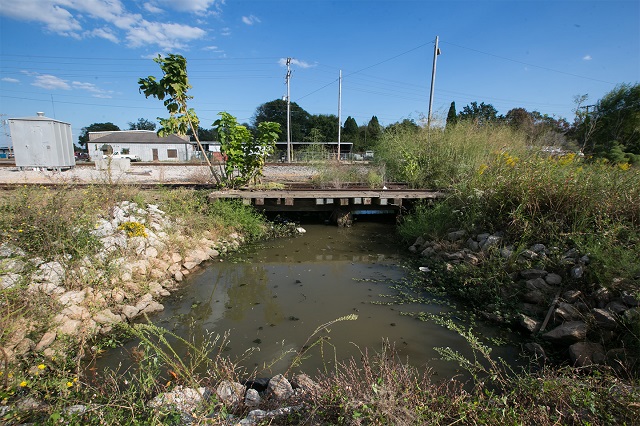 A polluted ditch containing creosote runs along the property of the old Kerr-McGee site in Columbus, Mississippi. (Photo: Nicole Craine for The Intercept)
A polluted ditch containing creosote runs along the property of the old Kerr-McGee site in Columbus, Mississippi. (Photo: Nicole Craine for The Intercept)
Tennie White’s prosecutors never claimed that there was any harm caused by the wastewater tests at the center of White’s case. And Wilson, who has worked in the environmental field for more than 25 years, said there was little reason to be concerned about the company’s wastewater. “They would have had to do something outside their norm to have caused any harm.”
Noting that BorgWarner didn’t have a valid permit for its wastewater, Wilson said, “I still don’t understand to this day why they went after Ms. White. If the Justice Department is going to go after anyone, it should have gone after BorgWarner for not meeting the standards of their pre-treatment permit.”
According to Wilson, if authorities were concerned about the dangers posed by the wastewater, they would have done further testing. “If you say the person didn’t test right, then you have to retest. You have to look, you have to see if there’s an out of control condition,” said Wilson, who noted that such an investigation didn’t happen. “Why didn’t the EPA and the MDEQ immediately call for tests to make sure they were in compliance? They should have had a whole team up there retesting the water, redoing testing, redoing sampling. But there was no sense of urgency there.”
For their part, prosecutors argued that White had lied about having done the tests, and that lies themselves do damage by undermining trust in the government’s environmental oversight.
“The whole system would kind of break down if we could not trust the data that was submitted to us,” Harry Wilson, the chief of the environmental permits division of the MDEQ, told the jury when testifying for the prosecution. Parker, the former head of the EPA’s criminal enforcement office, offered the same rationale for prosecuting any case in which protocol wasn’t followed, even if no harm was done: “If you don’t have that level of honesty and accurate reporting, the whole environmental compliance structure can potentially crumble.”
But for the people close to her, White’s prosecution only cemented their mistrust in government. At her sentencing hearing, Powers, the prosecutor, repeatedly and unsuccessfully tried to get Jamison to admit that White had committed a crime.
Powers: And if I was to prove to you that she had committed other crimes, if I showed you evidence —
Jamison: But you haven’t. So I don’t.
Powers: If I did show you evidence, if I convinced you beyond a —
Jamison: I would not believe the evidence because I think the ability is there to manipulate them. So I would not believe them.
Powers: And isn’t it also true that the ability is there for the defendant to manipulate information she’s providing you?
Jamison: But I know her.
Jamison is recovering from his ordeal, at least financially. He received an undisclosed amount from a settlement Kerr-McGee made with some Columbus residents living near its plant. The Maranatha Church declared bankruptcy in 2003, but is now in the process of receiving a settlement from a trust set up through the bankruptcy court. Jamison is now on dialysis, however, which he believes is related to kidney damage he sustained while digging in the ditch. But a suit over his and the other workers’ injuries was dismissed.
What has not survived the lengthy journey he and White took through the system meant to protect Mississippi’s environment is his faith in government. As Jamison firmly told Powers in the courtroom, he believes there was a conspiracy to convict Tennie White.
For his part, Jones sees White’s prosecution as a modern day lynching. “If Tennie was back in the ’30s, ’40s, or ’50s, they’d simply hang her or tar and feather her,” he told me. “To put an advocate in her place in 2016, you just destroy their ability to make a living. That is Mississippi in 2016.”
Jones won’t specify who exactly “they” are — and believes it doesn’t matter. “It’s no one person, no one agency, no one company,” he said. “BorgWarner, Kerr-McGee, Anadarko — the system is the same. At the end of the day, Tennie was a problem to anybody who didn’t hold the interests of the general public at heart.”
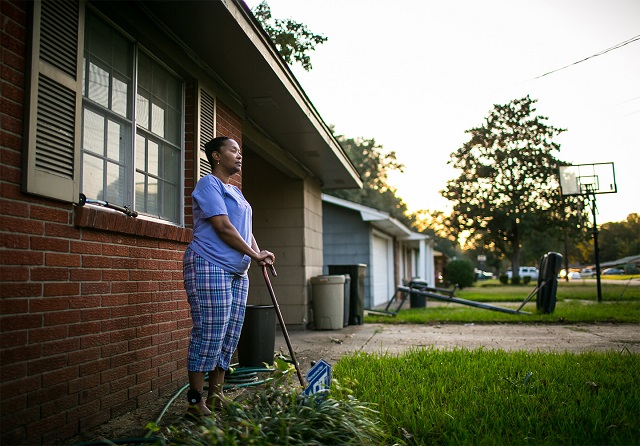 Tennie White outside of her home in Jackson, Mississippi. (Photo: Nicole Craine for The Intercept)
Tennie White outside of her home in Jackson, Mississippi. (Photo: Nicole Craine for The Intercept)
It was hard to imagine the person I saw on the pavement outside the federal prison crossing the street by herself, let alone committing a crime that would land her in prison. White had developed cataracts during her more than two years behind bars, and they had worsened to the point where she needed help getting around. She was standing on the curb, wearing a pale gray cotton sweatsuit, holding a cane, and smiling expectantly.
The elder of her two sons, Troy, pulled up to the prison, bearing gifts he knew she’d like: fresh blueberries, strawberries, and the Holy Bible. Troy didn’t know much about his mother’s work or fully understand why she had been incarcerated, but said he knew his mother’s spirit. “She’s not a go-quietly person,” he said with an affectionate laugh.
That spirit was alive and well during White’s 27 months in prison, when she helped fellow inmates learn to read and wrote to various governmental agencies, including the Occupational Safety and Health Administration and the EPA, to whom she complained about overflowing human waste and the prison’s dangerous use of untrained workers to demolish load-bearing walls.
After her release, White spent several weeks in a halfway house and several months under house arrest in Jackson. Her ankle monitor was removed on October 4 and she is now awaiting surgery for her cataracts. Afterward, she is hoping to return to her work in Crystal Springs and Hattiesburg. “The people there tell me still nothing’s being done.”
Reprinted with permission from The Intercept.
Our most important fundraising appeal of the year
December is the most critical time of year for Truthout, because our nonprofit news is funded almost entirely by individual donations from readers like you. So before you navigate away, we ask that you take just a second to support Truthout with a tax-deductible donation.
This year is a little different. We are up against a far-reaching, wide-scale attack on press freedom coming from the Trump administration. 2025 was a year of frightening censorship, news industry corporate consolidation, and worsening financial conditions for progressive nonprofits across the board.
We can only resist Trump’s agenda by cultivating a strong base of support. The right-wing mediasphere is funded comfortably by billionaire owners and venture capitalist philanthropists. At Truthout, we have you.
We’ve set an ambitious target for our year-end campaign — a goal of $125,000 to keep up our fight against authoritarianism in 2026. Please take a meaningful action in this fight: make a one-time or monthly donation to Truthout before December 31. If you have the means, please dig deep.